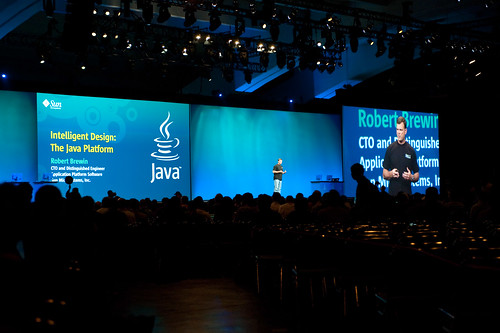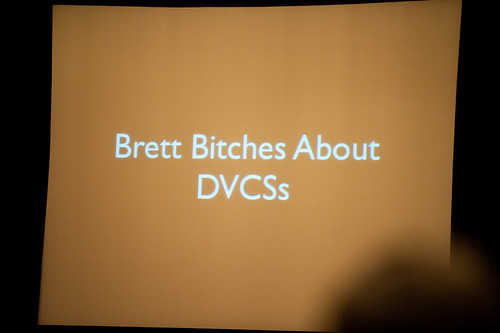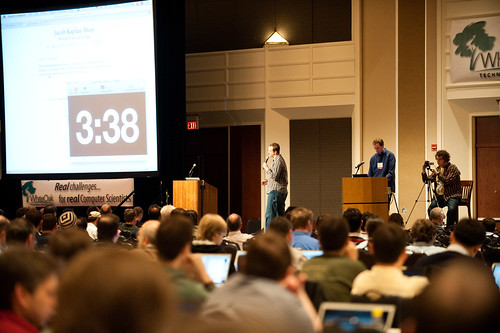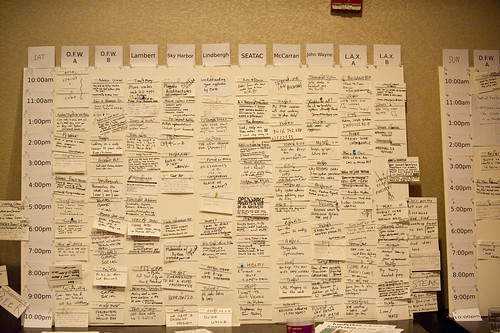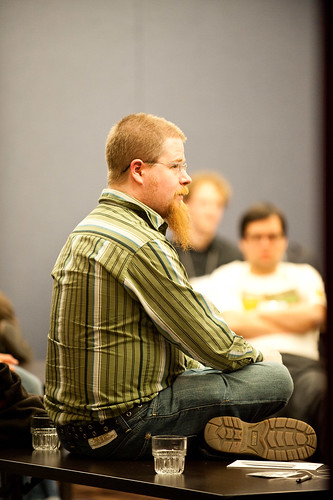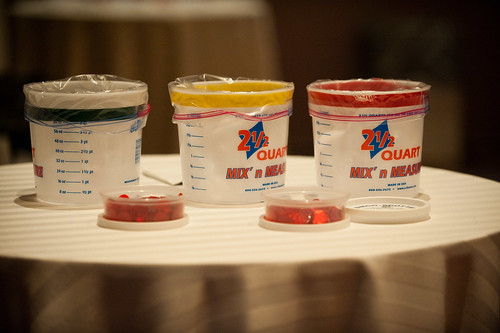It’s been a while since I have written a post, or been to a conference. I wish that I had time to write more and that I could write about what I am up to. In lieu of that, here is a report on Strange Loop 2013, which is the only conference that I am attending all year.
Emerging Languages Camp
One does not attend Strange Loop without attending Emerging Languages Camp (ELC). I view the camp as a kind of roulette. Of course it’s unlikely that many, or perhaps any of the languages presented in the forum will ever see widespread adoption. That’s not really the point. The camp is about getting language designers and implementors together, and giving them a forum to exchange ideas. Much of what has happened in languages recently is that we’ve been taking old ideas and trying to recast them in a modern context, either because computing platforms are now fast enough to bear the inefficiencies of those ideas, or because the computing community as a whole appears to be of a mind to accept them. ELC is also just a place for people who want to experiment with languages. Here was some of what stood out to me:
- Gershwin – an embedding of Forth semantics in Clojure – apparently this can be helpful when one is using the Clojure threading macros all over the place
- Noether – a highly stratified approach to language design. Unfortunately this talk dwelt too much on the philosophy and mathematical semantics and ran out of time before covering the details of the actual language. It’s a shame that we didn’t get to see the full content.
- Qbrt bytecode – This was an interesting look at a byte code system for a different design space, where the byte code was representing somewhat high level functionality as opposed to machine level instructions.
- J – J is cool because it’s basically APL 2.0. But now we also have R, Julia, and other languages. This is a space that has many contenders but no clear leader. My problem with J is that it looks even more write only than Perl.
- BODOL – This talk wasn’t interest so much for the language, which the presenter acknowledged was “another toy lisp”, but for the presentation, which involved HTML based slides being displayed inside of Emacs. I felt like I was back in 6.001 watching the construction of a lisp, but the presentation quality was really high, which made for a great talk.
In addition to the talks I had a number of dinner and hotel lobby discussions around ELC related topics. The ELC attendees are a great bunch.
Sessions
Jenny Finkel from Prismatic gave a great overview of how they use machine learning in the product. As a user this was a great explanation of how the system really works. Machine learning in keynotes is fough because it’s not something that everyone has studied so it is hard to get the level right. I definitely enjoyed it. The most useful information in the talk was when she said that coding on an iPad version has begun. I will definitely be using the living daylights out of that when it comes out.
This year there was definitely a theme around making it easier to deal with asynchronous / event-driven systems. I was able to make it to two of the talks – there were several more. Matthew Podwysocki and Donna Malayeri from Microsoft presented on the Rx extensions, which I’ve written plenty about on this blog already. This time they came with some cool Kinect based demos. Nice to see something other than web systems. The other talk that I saw was Rich Hickey’s talk on core.async. As usual, Rich brought a great mix of theoretical concerns around core.async’s CSP based model, while melding it with treal world system building. I consider this to be a hallmark of Rich’s style, and he is one of the very very few people who is really able to fuse theory and practice into a whole. And of course, Clojure is the manifestation of that fusion. I’ve got a bunch of David Nolen’s posts on core.async in tabs in my browser, but just haven’t had the time to sit down and read them. I feel a little more caught up now.
Another talk that I really enjoyed was Martin Odersky’s keynote on “The Trouble with Types“. The beginning of the talk was about the usual comparison between static and dynamic typing, and the end of the talk was about his work on Dotty, which is his new work on types based on “projecting higher kinded functional types onto names in modules”. He hopes that Dotty will eventually become the foundation for a future version of Scala. The interesting part for me happened in the middle of the talk, because that was the part where he admitted to some of the problems with types. Like needing a debugger for your type system because it had become so computationally powerful. The aha moment for me was around his discussion of how orthongonality in the type system design had contributed to the problems that he saw with Scala’s type system. It is a tenet among computer scientist that orthogonality is desirable. It was one of the foundational arguments in the CISC vs RISC computer architecture wars, and it is a badge of honor among language designers to have as much orthogonality as possible. However, orthogonality leads to a potentially large surface area of possibilities and interactions, which users need to master and be aware of, and which implementors need to implement completely and efficiently. On reflection, this should be obvious, but the lights went on for me during the talk.
I stopped into to see the latest installment of Friedman and Byrd’s journey with MiniKanren. I was very interested to see their exploration of the Chomsky hierarchy (of computational complexity). As usual, this is related to my interest in Clojure’s core.logic. They “cheated” a little bit in what they showed, but it was still interesting.
Avi Bryant gave a great talk on the applicability of abstract algebra, well mostly monoids, to the type of streaming calculations that are needed in many analytics systems. He showed how this provides a foundation for solutions like hyperloglog, min-hash, and count-min sketch.
Crista Lopes gave a talk called Exercises in Style which was about styles of programming. She observed that within teams, one can often figure out who wrote a piece of code just by looking at it. Another observation was that in art, students are taught what comprises the various styles and how to produce them. I thought that this was leading to a very promising discussion. She then presented the same program written in 9 different styles that she had observed. The first 3-4 styles (which have numbers and not names yet) were really what I was expecting to see. As we moved to more styles, they started to look like language paradigms, which I think is less interesting. Lopes is working on a book on this topic and has 33 styles that she’s identified so far. I’ll be keeping my eye out for that.
Another theme at Strange Loop this year was diversity. You saw it both in the speakers roster and in the session content. I didn’t get a chance to ask him, but I am pretty sure that Alex Miller made a very concerted effort to invite women speakers, because there was a much higher number of women speakers than last year, and also much higher than any other conference that I can remember. On the content side, there were several sessions. There was a good presentation on the history of women in computing. I definitely learned a bunch of things. The focus was on the early history of computing which was great, but I was disappointed that several prominent women in recent history were omitted. That’s the problem with histories, invariable someone gets left out. Some history is better than no history, especially on this topic. Alex also invited Jen Myers to do one of the keynotes. I’m not sure how to summarize this presentation because there are too many different angles. There was the angle about diversity, there was the angle about boosting education, there was the angle of making something good because we are good as people. So rather than try, I’ll just insert a Ray Bradbury quote that Jen used in her talk. This version is longer than the version in the talk, but it speaks to me.
I think it’s part of the nature of man to start with romance and build to a reality. There’s hardly a scientist or an astronaut I’ve met who wasn’t beholden to some romantic before him who led him to doing something in life.
I think it’s so important to be excited about life. In order to get the facts we have to be excited to go out and get them, and there’s only one way to do that — through romance. We need this thing which makes us sit bolt upright when we are nine or ten and say, ‘I want to go out and devour the world, I want to do these things.’ The only way you start like that is with this kind of thing we are talking about today. We may reject it later, we may give it up, but we move on to other romances then. We find, we push the edge of science forward, and I think we romance on beyond that into the universe ever beyond. We’re talking not about Alpha Centauri. We’re talking of light-years. We have sitting here on the stage a person who has made the film* with the greatest metaphor for the coming billion years. That film is going to romance generations to come and will excite the people to do the work so that we can live forever. That’s what it’s all about. So we start with the small romances that turn out to be of no use. We put these tools aside to get another romantic tool. We want to love life, to be excited by the challenge, to life at the top of our enthusiasm. The process enables us to gather more information. Darwin was the kind of romantic who could stand in the middle of a meadow like a statue for eight hours on end and let the bees buzz in and out of his ear. A fantastic statue standing there in the middle of nature, and all the foxes wandering by and wondering what the hell he was doing there, and they sort of looked at each other and examined the wisdom in each other’s eyes. But this is a romantic man — when you think of any scientist in history, he was a romancer of reality.
Alex has historically done a great job of getting great speakers for Strange Loop, and just just recent stars, but pioneers and old timers. This year we had Chuck Moore, Dan Friedman, and Douglas Hofstader. This year’s closing keynote was Hofstader, whose book “I am a Strange Loop” was the inspiration for the name of the conference. Hofstader’s talk was an exploration of that topic, and was everything that you could have hoped for given Hofstader’s amazing works of literature. What one could not have hoped for, however, was what followed. Alex commissioned David Stutz to do a multimedia performance based on Hofstader’s work. “Thrown for a Loop: A Carnival of Consciousness” was a performance that involved theater, a 5 piece brass quintet, Macintosh driven multimedia (including forays into Emacas and Clojure’s nREPL), and an aerialist. You will have to go and watch the video when it comes out, because I don’t have the words to describe it.
Miscellanea
Thursday night of Strange Loop we were treated to a conference party at the City Museum in St. Louis, which can only be described as part architectural museum and part playground, or as @petrellic put it “A habit rail for adults”. This was one of the most amazing venues that I have ever been to for a conference party. The three hours that we were allotted vanished quickly as we all explored the mysteries of the museums and its paths, trail, tunnels, stairways, and slides.
I’ve always had a little trouble describing what Strange Loop is to my coworkers and friends. I found a tagline, courtesy of @samberan: “Strange Loop is TED for programmers”.
Conference organizers take note: Strange Loop has seriously raised the already high bar on you.
